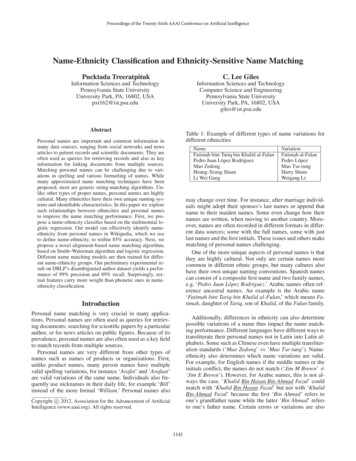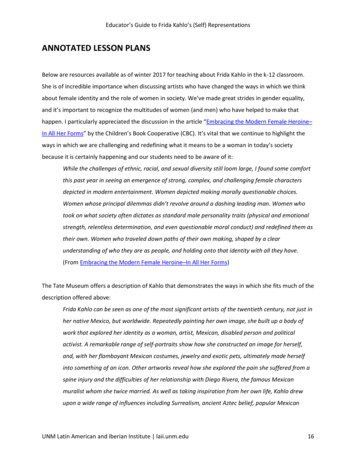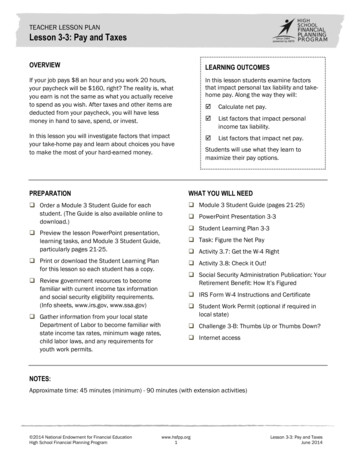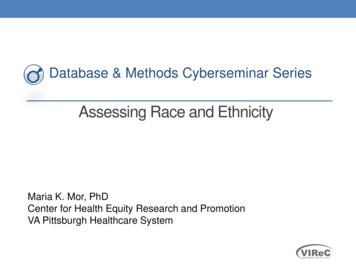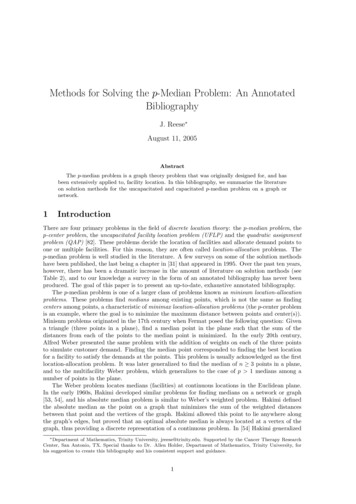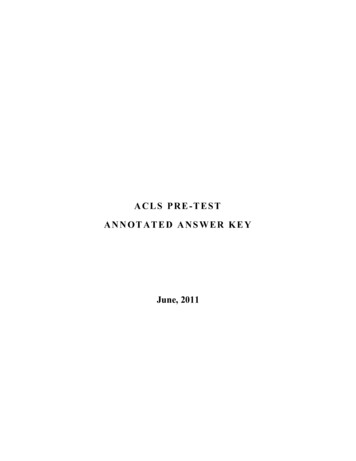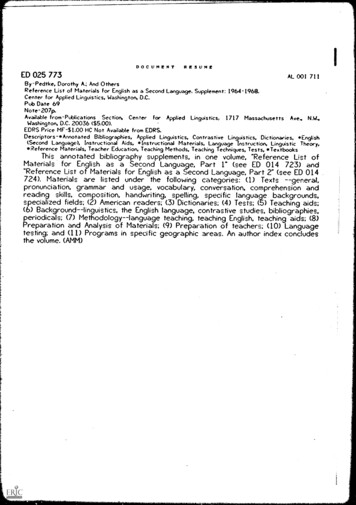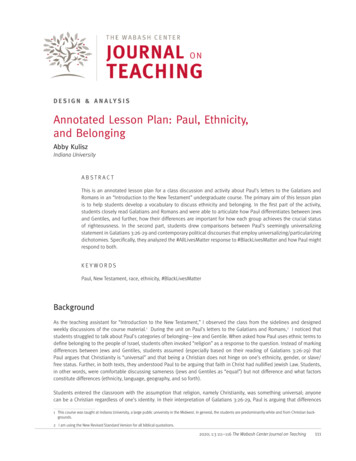
Transcription
D E S I G N & A N A LY S I SAnnotated Lesson Plan: Paul, Ethnicity,and BelongingAbby KuliszIndiana UniversityABSTRACTThis is an annotated lesson plan for a class discussion and activity about Paul’s letters to the Galatians andRomans in an “Introduction to the New Testament” undergraduate course. The primary aim of this lesson planis to help students develop a vocabulary to discuss ethnicity and belonging. In the first part of the activity,students closely read Galatians and Romans and were able to articulate how Paul differentiates between Jewsand Gentiles, and further, how their differences are important for how each group achieves the crucial statusof righteousness. In the second part, students drew comparisons between Paul’s seemingly universalizingstatement in Galatians 3:26-29 and contemporary political discourses that employ universalizing/particularizingdichotomies. Specifically, they analyzed the #AllLivesMatter response to #BlackLivesMatter and how Paul mightrespond to both.KEYWORDSPaul, New Testament, race, ethnicity, #BlackLivesMatterBackgroundAs the teaching assistant for “Introduction to the New Testament,” I observed the class from the sidelines and designedweekly discussions of the course material.1 During the unit on Paul’s letters to the Galatians and Romans,2 I noticed thatstudents struggled to talk about Paul’s categories of belonging—Jew and Gentile. When asked how Paul uses ethnic terms todefine belonging to the people of Israel, students often invoked “religion” as a response to the question. Instead of markingdifferences between Jews and Gentiles, students assumed (especially based on their reading of Galatians 3:26-29) thatPaul argues that Christianity is “universal” and that being a Christian does not hinge on one’s ethnicity, gender, or slave/free status. Further, in both texts, they understood Paul to be arguing that faith in Christ had nullified Jewish Law. Students,in other words, were comfortable discussing sameness (Jews and Gentiles as “equal”) but not difference and what factorsconstitute differences (ethnicity, language, geography, and so forth).Students entered the classroom with the assumption that religion, namely Christianity, was something universal; anyonecan be a Christian regardless of one’s identity. In their interpretation of Galatians 3:26-29, Paul is arguing that differences1 This course was taught at Indiana University, a large public university in the Midwest. In general, the students are predominantly white and from Christian backgrounds.2 I am using the New Revised Standard Version for all biblical quotations.2020; 1:3 111–116 The Wabash Center Journal on Teaching111
AN N OTAT E D L ESS ON P L A N: PAU L , ET HNICITY, AN D BE LON G I N Gbetween Jews and Gentiles are irrelevant because Christianity is universal—that is, being a Christian is an option availableto anyone. I found that students’ vocabulary was preventing them from understanding the first-century categories that Paulused. “Religion” and “Christianity” are modern categories and not ones that first-century writers employed; rather, they oftentheorized difference and belonging through ethnicity (for example, descent through Abraham).3Paul is not concerned with persons identifying as a member of a specific religion but with obtaining a specific status,“righteousness,” with God. As an eschatological Jew, Paul held that persons who had the status of righteousness wouldbe saved when the eschaton arrives. To be sure, Paul does argue that righteousness is open to all and is not dependent onone’s gender, ethnicity, or slave/free status. Yet, Paul is clear that differences between Jews and Gentiles are critical in theprocess of obtaining this status. God had already promised salvation to the people of Israel, but salvation for the Gentilesis not a guarantee and must be achieved through another mechanism—faith (Romans 11:1, 23-26). Paul, then, depicts Israelas a natural olive tree, and Gentiles as wild branches that can be included by being grafted onto the tree. Still, he privilegesIsrael’s “cultivated tree” over the Gentiles’ inferior grafted branches: “You stand only through faith. So do not become proud,but stand in awe” (Romans 11:20). What is more, in Romans 4, Paul also constructs his own version of ethnic belonging4through Abraham. He argues that Abraham is the common ancestor of both Jews and Gentiles (that is, the circumcised anduncircumcised). The basis of his argument is the plural “nations” in Genesis 17:4: “You shall be the ancestor of a multitude ofnations.” By crafting his own conception of ethnic belonging, Paul places the Gentiles firmly within the confines of the peopleof Israel where they are able to obtain righteousness.My strategy for discussion sections, then, was to help students cultivate a vocabulary to discuss the categories that Paul, apre-modern author, used to conceptualize difference, particularly ethnicity. I wanted students to see how Paul is not makinguniversalizing statements about religion but rather theorizes how both Jews and Gentiles can belong to Israel and attainrighteousness while being different from each other. Since we were on the topic of universalizing discourses, I used thisclass as an opportunity to discuss contemporary political discourses that employ universalizing and particularizing language.In Paul’s case, it is modern readers who interpret sections of Galatians and Romans as universalizing due to the modernunderstanding of religion (especially Christianity) as universal. Some contemporary discourses use universalizing language(for example, “all,” “every,” and so forth) to obscure claims that are directed toward certain persons and groups. I thus choseto pair Paul with the #AllLivesMatter response to #BlackLivesMatter, which was popularized on Twitter by the #BLM and#ALM hashtags.Learning Objectives1. Students will be able to articulate why and how ethnicity matters for Paul in his letters to the Galatians and Romans. Students will analyze Galatians 3 and discuss how Paul differentiates Jews and Gentiles Students will analyze Romans 11 and explain Paul’s more detailed argument about how (1) differences between Jewsand Gentiles are important for how each one achieves righteousness and becomes “in Christ”; and(2) how Paul conceives of ethnicity in terms of belonging to a common ancestor (such as Abraham)2. Students will be able to draw comparisons between Paul and contemporary discourses that use universalizing terminology Students will discuss the #ALM response to #BLM Students will discuss whether or not Paul would use the #ALM hashtag3 To be fair to my students, the applicability of “religion” is also a contemporary debate among scholars of antiquity. Brent Nongbri (2013), for example, has accusedscholars of antiquity of retrojecting “religion” into the premodern world, as evidenced by their translations of various words in ancient languages as “religion”or “religious.” At the heart of this error in translation is the pervasive idea that religion is something universal and timeless rather than a historically specific andconstructed concept.4 While I primarily used “ethnicity” instead of “race” in the classroom, I acknowledge that the distinction between the two is slippery. As Denise Kimber Buell (2005)describes, scholars often prefer ethnicity over race, as the latter is commonly associated with the nineteenth-century European interest in using biology and genetics to justify genocide and discrimination against certain populations of people. Ethnicity, in contrast, is viewed as an acceptable alternative because it impliesless fixity and more mutability; it privileges common ancestry but leaves room for factors such as language, geography, eating habits, and so forth. Yet, Buell notesthat ethnicity too is a modern category and also contains fixity, particularly in relation to its emphasis on kinship and common ancestry. She ultimately prefers todescribe race/ethnicity in terms of fixity and fluidity in her analysis of early Christian texts. In this way, “appeals to kinship and descent are one significant way inwhich the ‘reality’ and ‘essence’ (or fixity) of ethnicity/race is articulated” (9). Likewise, texts can also appeal to fluidity: “When kinship and descent participate inthe fluid aspect of ethnicity, insofar as descent and kin relations shift and can be redrawn (discursively or ritually) to exclude and include individuals and groups,these signs of fluidity are often accounted for by asserting that ethnic claims of descent and kinship are ‘fictive” rather than ‘real’” (9).1122020; 1:3 111–116 The Wabash Center Journal on TeachingThis work is licensed under a Creative Commons Attribution-NonCommercial 4.0 International License
KULISZActivity (Part I): Thinking About Ethnicity Instead Of Religion Students have already read Paul’s letters and came to class prepared with a notecard responding to the open-endedquestion: “What does Paul think about the differences between Jews and Gentiles?” Some students volunteered to share their responses with the class, and I wrote down some key terms and phrases(see Figure 1):Figure 1In groups, students answered the same question (groups look at either Galatians 3 or Romans 11), but are not alowed to usethe following terms: Religion Faith Belief Christian/Christianity Students are required to use the following terms in their responses: Ethnicity People (in other words, belonging to a group or “people”) Jew Gentile Students shared their responses, which incorporated this new terminology. I wrote down key terms and phrases(see Figure 2):2020; 1:3 111–116 The Wabash Center Journal on Teaching113
AN N OTAT E D L ESS ON P L A N: PAU L , ET HNICITY, AN D BE LON G I N GFigure 2After removing “religion” and other similar terms from students’ vocabulary, it was easier to lead discussion about ethnicityand belonging. Without “religion,” they were challenged to look more closely at their primary sources and think with firstcentury terms. In our discussion, the students who looked closely at Galatians 3 were able to see how Paul delimits differencein his statement in 3:26-29 that there is “no longer Jew or Greek.” They identified his modifying phrase “in Christ Jesus” (3:28)as a way to describe belonging to the community that will survive the eschaton. They further pointed out “righteousness”(3:11) as the special status that both Jews and Gentiles needed to achieve in order to become a part of this community.While differences will not matter for those who become “in Christ” and survive the eschaton, the students who analyzedRomans 11 were able to describe how differences between Jews and Gentiles do matter in order to achieve righteousness.They discussed, for example, Paul’s metaphor for the people of Israel as a natural olive tree and the Gentiles as wild branchesthat need to be grafted onto the tree. They were able to point out how this metaphor privileges the people of Israel as naturaland cultivated compared to the wild and unruly Gentiles. I further prodded students to consider Romans 4; I asked them tothink about how Paul theorizes ethnicity in relation to Abraham. We discussed how Paul makes a radical move by identifyingAbraham as the common ancestor to both the Jews and Gentiles. The latter, too, could claim descent from Abraham throughthis alternative means. With their new vocabulary, students could now articulate how Paul defined ethnicity and how Jews andGentiles could each claim Abraham as their progenitor but in different ways.Activity (Part II): Is Paul Saying #ALLLIVESMATTER?In the remaining portion of class, we discussed how contemporary political discourses make use of universalizing statements.Most of my students were already familiar with the #BLM and #ALM debate but in order to smoothly transition into thisdiscussion, I began with a brief free-writing activity about how #BLM and #ALM might relate to Galatians and Romans. Thefirst part of class seemed to prime students for this discussion, as they quickly pointed out that #BLM focused on race anddifference while #ALM claimed universality and sameness. We then discussed how #ALM hides its whiteness under a cloakof ideals such as sameness, equality, and the universal. In this way, it portrays #BLM as being concerned with identity, race,and the particular.I then asked students if Paul would use the #ALM hashtag. We discussed how on the surface it may seem like Paul isadvocating for #ALM, but on a closer look, his statement in Galatians 3:26-29 only refers to persons once they had obtainedrighteousness. While differences will not persist once one eventually becomes “in Christ,” he argues that the differencesbetween Jews and Gentiles mandate separate mechanisms for each to achieve this status. As we discussed earlier, Paul even1142020; 1:3 111–116 The Wabash Center Journal on TeachingThis work is licensed under a Creative Commons Attribution-NonCommercial 4.0 International License
KULISZcreates his own ethnic argument based on Genesis 17:4, wherein Jews and Gentiles are both descendants of Abraham. Wespent the rest of class brainstorming Paul’s hashtags (see Figure 3):Figure 3I found that pairing Galatians and Romans with #BLM and #ALM was instructive and helpful for students. Although studentsinitially shied away from talking about difference and ethnicity, they spoke more openly and fluidly about it when I providedguidelines and specific terminology they could use. Providing specific words (and restricting others) proved useful whenstudents disagreed with or challenged my lesson plan. For example, when a student interjected “But isn’t Paul a Christian?” Iwas able to note that Paul never refers to himself as a Christian but rather as a Jew.In the second part of class, the discussion and hashtag activity helped students see the work that universalizing languagedoes; it can conceal its own biases under the cover of sameness and equality. Students were also ab
Annotated Lesson Plan: Paul, Ethnicity, and Belonging Abby Kulisz Indiana University ABSTRACT This is an annotated lesson plan for a class discussion and activity about Paul’s letters to the Galatians and Romans in an “Introduction to the New Testament” undergraduate course. The primary aim of this lesson plan is to help students develop a vocabulary to discuss ethnicity and belonging .
